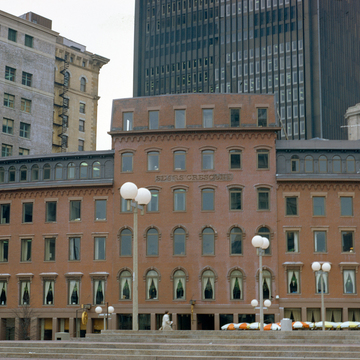Two of the few buildings to escape the demolition of Scollay Square in preparation for the new Government Center complex in the 1960s, the Sears Crescent and the Sears Block document the importance of Cornhill Street, once the center for Boston's bookstores. The Sears Crescent, originally a simple red brick five-bay, six-story unit flanked by nine-bay, five-story wings, was elaborated with Italianate window hoods in the mid-nineteenth century. The Sears Block is one of the best surviving examples of the severe (more so since the sash windows were replaced by single panes of glass), trabeated-granite, commercial architecture characteristic of Boston in the second quarter of the nineteenth century. The projecting steaming teakettle, originally a sign for the Oriental Tea Company nearby in Scollay Square, remains a beloved element of the City Hall Plaza (GC15) streetscape.
You are here
Sears Crescent and Sears Block
1816; 1969, Don Stull Associates. 36–68 Cornhill St. 1848; 1969, Stahl/Bennet Associates. 70–72 Cornhill St.
If SAH Archipedia has been useful to you, please consider supporting it.
SAH Archipedia tells the story of the United States through its buildings, landscapes, and cities. This freely available resource empowers the public with authoritative knowledge that deepens their understanding and appreciation of the built environment. But the Society of Architectural Historians, which created SAH Archipedia with University of Virginia Press, needs your support to maintain the high-caliber research, writing, photography, cartography, editing, design, and programming that make SAH Archipedia a trusted online resource available to all who value the history of place, heritage tourism, and learning.


